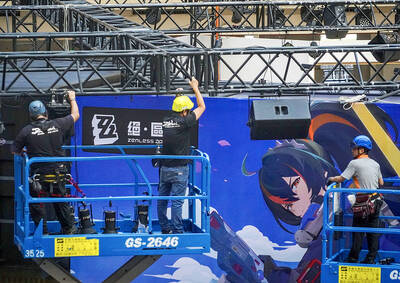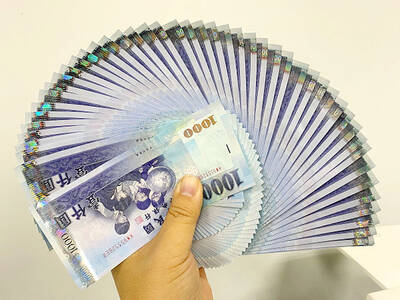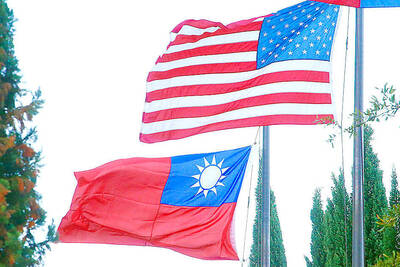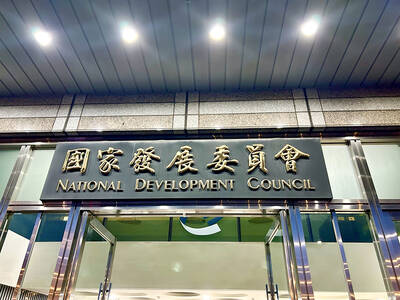To Brazilian Claudio Roberto Lopes, or “Toddy,” coming to Taiwan and being a soccer coach was not a difficult decision to make.
“My girlfriend wanted me to choose between her and soccer, and I said ‘I love soccer,’ and here I am,” he said, adding that he had never heard of a soccer team in Taiwan before he came.
Lopes arrived earlier this year with three other Brazilian coaches at the invitation of the Chinese Taipei Football Association (CTFA), which launched the project “Taiwan Football Dream” (台灣足球夢) that aims to enable the soccer team to qualify for the 2038 World Cup.
A crucial part of the project is to have Brazilian coaches train young soccer players in Taiwan.
For the moment, Lopes and two other coaches — Levi Villibor and Claudio Fernandes Ribeiro — are still here coaching players at high schools and universities. All three used to play in Brazil’s professional soccer league before becoming full-time coaches.
Joined by Villibor and Ribeiro, Lopes sat down with the Taipei Times earlier this month to share their views on the sport in Taiwan.
“Boys and girls, on average, are all good in their soccer skills,” he said. “And overall, girls here are more disciplined, focused and determined to win than boys.”
Lopes said training at the beginning was somewhat difficult because of the language barrier and players’ changing positions during games. But the three coaches said the players showed them great respect and quickly grasped their instructions.
The main problem, meanwhile, was a lack of a fighting spirit, Lopes said.
“They are not aggressive enough when they play,” Lopes said. “You win, or you lose, it’s OK, but you must fight like a warrior.”
That lack of fight, as Lopes said, may have a lot to do with Taiwanese culture.
For one, soccer is not a very popular sport here.
“Education is still a very important matter for many students here and they spend too much time studying,” Lopes said, adding that this leaves players with hardly enough time to do quality training.
Brazil built its reputation as a soccer country after winning five World Cups since 1958, Lopes said, and it is common to see small children play soccer on the streets. Since in Brazil education is generally a privilege for rich people, many children from poor families aspire to play in the professional soccer league because the high salaries mean they can support their families, he said.
Every school in Brazil makes sure that its soccer players are fully developed and continue to improve their skills — without compromising their education.
“Here, not every school has a soccer team,” he said.
Nonetheless, Lopes said it is possible to change culture and that this change must begin in schools.
“You need to have at least one soccer coach in every school,” he said.
Players also need more time for training. The more they practice, the more evolucao (Portuguese for “developed”) they get, he said.
Lopes said Taiwan “has no problem” in meeting the requirements for a professional soccer team, at least in terms of infrastructure.
Asked about how the corporate sector could be encouraged to support soccer, he said all it takes is for “the government and the companies to sit down and talk.”
In Brazil, the government gives tax breaks for firms that support soccer teams or sponsor games, he said.
Lopes said Taiwan’s situation with soccer was similar to Brazil’s with volleyball 16 years ago, when the volleyball team was simply no match to more experienced teams from China, the US or Australia.
However, with help from the government and corporations, volleyball is now the second most important sport in Brazil, he said. The women’s national volleyball team won the gold medal at the Beijing Olympics, while the men’s team won the silver. Both men’s and women’s teams are currently ranked No. 1 in the world by the International Volleyball Federation.
He said both South Korea and Japan faced the same problems with soccer years ago, but eventually the sport gained momentum in both countries because “somebody had a dream.”
“I have a dream [for soccer in Taiwan],” he said. “In the last game you played against South Korea, you were beaten 2-0. After more practice, more training, you can beat them with a score of 4-2.”
The three will stay in Taiwan for at least another year and all have expressed a willingness to renew their contracts. People in Taiwan are very friendly, they said.
Just as the interview was about to wrap up, Villibor and Ribeiro showed clips they had found on YouTube about the “Soccer Hoopla” in Brazil — fans dancing and singing to cheer their favorite teams, or crying in disbelief when their team loses.
“I hope, Taiwan, one day, I hope,” Vilibor said, pointing at the screen. “It’s possible if every player can fight like Taiwan’s taekwondo fighter” Su Li-wen (蘇麗文).
Taiwan is ranked 173nd by FIFA.
The CTFA intends to have a professional soccer league by 2018, with six professional teams. The number of professional soccer teams is expected to grow to 12 by 2028. By 2038, Taiwan wants to be one of the top 32 countries in the world competing for the World Cup.
Readers interested in contributing to the “Taiwan Football Dream” project can visit the Web site at taiwanfootballdream.ctfa.com.tw/.

Taiwan is projected to lose a working-age population of about 6.67 million people in two waves of retirement in the coming years, as the nation confronts accelerating demographic decline and a shortage of younger workers to take their place, the Ministry of the Interior said. Taiwan experienced its largest baby boom between 1958 and 1966, when the population grew by 3.78 million, followed by a second surge of 2.89 million between 1976 and 1982, ministry data showed. In 2023, the first of those baby boom generations — those born in the late 1950s and early 1960s — began to enter retirement, triggering

ECONOMIC BOOST: Should the more than 23 million people eligible for the NT$10,000 handouts spend them the same way as in 2023, GDP could rise 0.5 percent, an official said Universal cash handouts of NT$10,000 (US$330) are to be disbursed late next month at the earliest — including to permanent residents and foreign residents married to Taiwanese — pending legislative approval, the Ministry of Finance said yesterday. The Executive Yuan yesterday approved the Special Act for Strengthening Economic, Social and National Security Resilience in Response to International Circumstances (因應國際情勢強化經濟社會及民生國安韌性特別條例). The NT$550 billion special budget includes NT$236 billion for the cash handouts, plus an additional NT$20 billion set aside as reserve funds, expected to be used to support industries. Handouts might begin one month after the bill is promulgated and would be completed within

NO CHANGE: The TRA makes clear that the US does not consider the status of Taiwan to have been determined by WWII-era documents, a former AIT deputy director said The American Institute in Taiwan’s (AIT) comments that World War-II era documents do not determine Taiwan’s political status accurately conveyed the US’ stance, the US Department of State said. An AIT spokesperson on Saturday said that a Chinese official mischaracterized World War II-era documents as stating that Taiwan was ceded to the China. The remarks from the US’ de facto embassy in Taiwan drew criticism from the Ma Ying-jeou Foundation, whose director said the comments put Taiwan in danger. The Chinese-language United Daily News yesterday reported that a US State Department spokesperson confirmed the AIT’s position. They added that the US would continue to

The National Development Council (NDC) yesterday unveiled details of new regulations that ease restrictions on foreigners working or living in Taiwan, as part of a bid to attract skilled workers from abroad. The regulations, which could go into effect in the first quarter of next year, stem from amendments to the Act for the Recruitment and Employment of Foreign Professionals (外國專業人才延攬及僱用法) passed by lawmakers on Aug. 29. Students categorized as “overseas compatriots” would be allowed to stay and work in Taiwan in the two years after their graduation without obtaining additional permits, doing away with the evaluation process that is currently required,